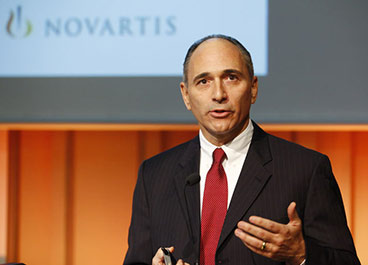Creating a Culture of Trust & Breakthrough Innovation in Pharma
Today’s pharma industry is suffering a crisis of trust. To thrive in this new environment, top leaders will not only have to develop innovative patient-centered models, they will also need to achieve enterprise-wide culture change and facilitate breakthrough innovation.

There is an urgent need for the pharma industry to redefine itself in the minds of stakeholders following the disappointing business and share price performance of recent years. Pharma companies must also win back trust; they have created the perception that they put their commercial goals above the interests of governments, payers, prescribers and patients.
According to PWC’s Report ‘From Vision to Decision Pharma 2020’, the pharma industry faces three fundamental challenges.
First, rising customer expectations. The commercial environment is getting harsher. Healthcare payers are imposing new cost constraints on providers and are scrutinising the value of medicines more carefully. They want new therapies that are clinically and economically better than the existing alternatives, together with hard, real-world outcomes data to back any claims about a medicine’s superiority.
Secondly, low scientific productivity. Pharma’s output has flatlined for the past decade. Yet the processes it uses to discover and develop new products remain much the same.
And thirdly, cultural sclerosis. The prevailing management culture, mental models and strategies on which the industry relies are the same ones it has traditionally relied on, even though they have been eclipsed by new ways of doing business.
The Big Pharma culture has been homogenised, purified, sterilised, whipped, stirred, filtered, etc. and lost its ability to ferment the good stuff required to innovate. This isn’t covered in most reviews of the productivity challenge facing our industry, because it’s nearly impossible to quantify, but it’s well known and a huge issue".
Life sciences venture capitalist Bruce Booth argues that pharma’s performance decline is largely a cultural problem. “The Big Pharma culture has been homogenised, purified, sterilised, whipped, stirred, filtered, etc. and lost its ability to ferment the good stuff required to innovate. This isn’t covered in most reviews of the productivity challenge facing our industry, because it’s nearly impossible to quantify, but it’s well known and a huge issue.” He cites three hallmark traits of the culture crisis facing pharma from his vantage point: tyranny of the committee, stagnation through risk avoidance and the negative impact of mega-mergers and reorganisations.
Booth isn’t alone in blaming the industry’s declining scientific productivity on cultural influences. In a recent survey of 150 R&D executives by Heidrick & Struggles, 54% cited lack of creativity as a key organisational issue, while 53% cited lack of coordination between the R&D and commercial functions.
The conclusion from a 2012 Nature article by researcher Jack Scannell: “The number of new drugs approved per billion U.S. dollars spent on research and development has halved roughly every nine years since 1950, falling around 80-fold in inflation-adjusted terms". It’s a stunning fact. And the pharmaceutical industry has been scrambling for a way to address it ever since.
Against this background, the results of a recently published article from Patient View Quarterly entitled ‘The Corporate Reputation of Pharma – The Patient Perspective’ based on a survey of 600 international, national and regional patient groups cannot be a surprise. Only 34% of respondents gave pharma a “good” or “excellent” rating for reputation. The patient groups listed a number of areas where pharma was rated as having a “poor” record including: a lack of fair pricing policies leading to unseemly profits (50%); a lack of transparency in all corporate activities (48%); management of adverse event news (37%); acting with integrity (32%).
There were a number of themes that supported these poor ratings: lack of affordable medicines, a perception that the industry is preoccupied with drugs that offer only short-term health benefits, inappropriate marketing of drugs and lack of transparency in reporting results from negative clinical trials.
In fairness to pharma, it has been working hard to improve in these areas and there are some great success stories. But it is time for the industry to redouble its efforts.
So what can the industry’s senior figures do to rebuild public trust and build healthy, high-performing companies to successfully meet pharma’s fundamental challenges of the future? They would be well advised to start by focusing on their culture as the most critical driver of breakthrough innovation and business success.
The importance of culture
We are often unaware of it but culture is dominant over innovation, strategy and leadership. No matter how great your strategy, the fact is, your culture and your people always make the difference".
Culture encapsulates your organisation’s self-sustaining patterns of behaving, feeling, thinking, and believing. We are often unaware of it but culture is dominant over innovation, strategy and leadership. No matter how great your strategy, the fact is, your culture and your people always make the difference. The strategy your company employs will only succeed when it is powerfully aligned to your culture. As Peter Drucker so famously stated, “Culture eats strategy for breakfast.” However, it is an area that is often neglected or poorly managed.
According to 84% of the more than 2,200 global participants in the 2013 Culture and Change Management Survey by Booz & Company, culture is critically important to business success. However, there is a clear disparity between the way companies view culture and the way they treat it. Less than half of participants saw their companies effectively managing culture, and more than half said a major cultural overhaul was needed.
Interestingly, 60% of C-suite executives see culture as a bigger success factor than either strategy or operating models.
They reported that companies that managed their cultures well saw revenue increases of 682% versus 166% for the companies that did not manage their cultures well – stock price increases of 901% versus 74% – and net income increases of 756% versus 1%".
In his latest book The Culture Cycle, Professor James L. Heskett of Harvard Business School concludes that effective culture can account for 20-30% of the differential in corporate performance when compared with “culturally unremarkable” competitors.
Even more remarkable were the findings of Kotter and Heskett’s landmark study. It documented results for 207 large U.S. companies in 22 different industries over an eleven-year period. They reported that companies that managed their cultures well saw revenue increases of 682% versus 166% for the companies that did not manage their cultures well – stock price increases of 901% versus 74% – and net income increases of 756% versus 1%. These results are staggering and highlight the impact of culture on performance and the bottom-line.
Kotter and Heskett found that strong corporate cultures facilitate adaptation to a changing world, highly value employees, customers, and owners and encourage leadership from everyone in the firm. So if customers need change, a firm’s culture almost forces people to change their practices to meet the new needs. And anyone, not just a few people, is empowered to do just that.
Culture, innovation and performance
Innovation is a byproduct of culture. It is not a byproduct of organization. It is not a byproduct of how much money you throw at it. It is not a byproduct of the processes that you use to run it. Therefore, you need to create a culture that will foster innovation".
Strong cultures don’t happen by accident or are only achievable by organizations with exceptional leaders or extraordinary products. What many companies don’t realize is that there are a number of practical “tools” (concepts and techniques designed to change the way individuals think and act) and processes that are proven to increase both individuals and the company’s future success and levels of innovation and to build and sustain a strong customer-centric culture.
Innovation is a byproduct of culture. It is not a byproduct of organization. It is not a byproduct of how much money you throw at it. It is not a byproduct of the processes that you use to run it. Therefore, you need to create a culture that will foster innovation. Apple’s late co-founder, Steve Jobs sums it up: “Innovation has nothing to do with how many R&D dollars you have. When Apple came up with the Mac, IBM was spending at least 100 times more on R&D. It’s not about money. It’s about the people you have, how you’re led, and how much you get it.”
Last year’s Global Innovation 1000 study confirms that spending more on R&D is not what drives results. The most crucial factors are strategic alignment and a culture that supports innovation.
The elements that make up a truly innovative company include: a focused innovation strategy, a winning overall business strategy, deep customer insight, great talent, and the right set of capabilities to achieve successful execution. More important than any of the individual elements, however, is the role played by corporate culture which can be viewed as the glue that bonds them all together. Yet according to the results of the study, only about half of all companies say their culture robustly supports their innovation strategy. Moreover, about the same proportion say their innovation strategy is inadequately aligned with their overall corporate strategy.
The study also found that companies with both highly aligned cultures and highly aligned innovation strategies have 30% higher enterprise value growth and 17% higher profit growth than companies with low degrees of alignment. Underperforming companies have much to gain if they can close these gaps and achieve higher degrees of cultural and strategic alignment.
Beyond the compound, it's the people and their passion that actually drive progress and innovation. Whether they are working in R&D, medical affairs, marketing or any other area, there is a culture of focus and commitment to literally making lives better. It is a collective vision, working closely together to cross the finish line, to bring new medicines to market, to make them a reality.”
Companies with strong innovation cultures think innovatively in everything they do and are constantly searching for better or more effective ways of doing things. The optimal outcomes are achieved when each person in the organization channels their creativity and actions toward: business growth, people development, an empowering and supportive culture, providing innovative tools and processes for effectiveness and executional excellence. Strengthening consumer and customer focus and trust, accountability for results, teamwork, and sense of urgency along with instilling an entrepreneurial, winning spirit are the key to achieving success. An innovative culture cultivates engagement, enthusiasm, challenges people to take risks in a safe environment, fosters learning, and encourages independent thinking. Effective innovation means that customers buy your products because they are distinctive and deliver benefits your customers really want.
While many people associate innovation with new products, people are the most important drivers of breakthrough innovation. Great people do great things and build outstanding businesses. That is why your major focus should be on the development of your people.
Dr. Eirum Chaudhri, Merck’s Global Director of Scientific Affairs says “Beyond the compound, it's the people and their passion that actually drive progress and innovation. Whether they are working in R&D, medical affairs, marketing or any other area, there is a culture of focus and commitment to literally making lives better. It is a collective vision, working closely together to cross the finish line, to bring new medicines to market, to make them a reality.”
The effectiveness of your people can be exponentially increased as they gain exposure to world class tools and processes, and selectively incorporate and utilize them. These tools include leadership, management and cultural tools supported by technology. Staff, managers and leaders should be encouraged to create, explore and devise new strategies to further develop leadership and technical skills. It is the leaders role to provide people the tools and resources necessary in order to open minds to possibilities of innovation.
“If you continuously tell people what they have to do, there won’t be any innovations. I believe in a decentralized management approach and small headquarters. You have to allow sufficient latitude, especially for creative scientists.”
For innovation to thrive it must exist in a culture that energizes and ensures that creative thinking is constantly occurring. Creativity, curiosity and a genuine openness are essential for breakthrough innovation. Creating a culture of trust where risks can be taken without a culture of blame and perceived failure is valuable as long as the people benefit through learning and discovery.
Roche Chief Executive Severin Schwan likes to crack open the champagne with his drug research teams at the end of a big project - especially when they are unsuccessful. As the boss of one of the world's most successful pharmaceutical companies, whose leading position in cancer treatments has propelled its market value to more than $250 billion, it might seem a strange response. But a celebration to mark the lessons learned from an unsuccessful experiment are an important component of Schwan's drive to encourage risk-taking in an intrinsically risky business, where nine out of 10 potential new drugs turn out to be flops. "We need a culture where people take risks because if you don't take risks, you won't have breakthrough innovation," he says.
Schwan likes to empower his people to encourage creativity. “If you continuously tell people what they have to do, there won’t be any innovations. I believe in a decentralized management approach and small headquarters. You have to allow sufficient latitude, especially for creative scientists.”
Creating an invigorating sense of purpose that goes beyond profit can have a powerful positive impact on both staff and customers. Profit may motivate senior executives but it rarely does so for the front-line employees unless they are shareholders. Connecting people to a purpose is an important way of helping them feel good about the company. Why? Because there is a very high correlation between the way your employees feel about the company and the way your customers do.
What motivates employees is feeling connected to an authentic company ethos. Creating products or providing services or serving causes that clearly add value in the world, make it possible for employees to derive a sense of meaning from their work, and to feel good about the companies for which they work. A true vision for a business rests on foundations of both purpose and values. The power of vision is at its best when it comes alive in the people of the organization and they ‘live the vision’. They become passionate about what they do and why they do it. The business goals must then align with this foundation. Without a clear foundation, a business will never be truly strategic. So it is better to stand for something beyond simply increasing profits.
One patient spoke very movingly about how before surgery she remembers smelling her child’s hair and wondering would that be the last time they'd be together. It’s a powerful medium to demonstrate to people the incredible work that we do and the results of their combined efforts and galvanizes their commitment in terms of what we are trying to achieve as a company.”

To demonstrate the impact of their work, Astellas invite patients who have undergone transplant surgery to come in to their offices and share their story with employees. Ken Jones, CEO of AstellasPharma EMEA recalls “One patient spoke very movingly about how before surgery she remembers smelling her child’s hair and wondering would that be the last time they'd be together. It’s a powerful medium to demonstrate to people the incredible work that we do and the results of their combined efforts and galvanizes their commitment in terms of what we are trying to achieve as a company.”
The single most important factor in driving culture, innovation and performance is positive and effective leadership behavior. Transformational leaders create new futures that are not constrained by past performance, or even current circumstance, and which inspire others to build those futures with them.
Former Lilly executive Bernard Munos has analyzed industry data to ascertain which pharma R&D operations have been most productive, and why. His analysis confirms Novartis has been one of the best performers over the last 15 years, and he believes that the company’s leadership and culture was instrumental in this success.
Ten years ago, as uninspired CEOs unleashed six sigma onto their scientists, Novartis was the only company to denounce the ineptitude of regimenting science and basing R&D investment on bogus forecasts and NPV calculations. It broke ranks with its peers, and returned to its scientists the freedom to pursue unfettered breakthrough innovation. It is now the company that derives by far the greatest percentage of its sales from new products.”
2002 was a pivotal year for Novartis. The company’s chief executive at the time, Daniel Vasella, took a handful of bold decisions that helped to shape its approach to R&D over the following decade. Vasella made a multi-million dollar bet by establishing a global research center in Cambridge, Massachusetts, USA drawing on the research and academic talent from MIT, Harvard, and other institutions in the area, and internationally. It has become the industry standard for open innovation and developing great people and new compounds. Vasella appointed Mark Fishman, M.D., who came from academic research at Harvard, to run the centre and gave him freedom to determine the R&D strategy. Vasella also insisted that the Novartis Institute for Biomedical Research should have complete independence from the firm’s marketing department.
Munos wrote in Forbes: “Ten years ago, as uninspired CEOs unleashed six sigma onto their scientists, Novartis was the only company to denounce the ineptitude of regimenting science and basing R&D investment on bogus forecasts and NPV calculations. It broke ranks with its peers, and returned to its scientists the freedom to pursue unfettered breakthrough innovation. It is now the company that derives by far the greatest percentage of its sales from new products.”
Drawing on the physician role models of his youth and his vision to build a great global health care company that could help people through lifesaving new drugs, Vasella built a company culture centered on compassion, competence, and competition. He told Fortune. “It may sound trite, but I truly believe my ability to keep shareholders’ faith in our company depends not on whether I make the quarter but on who I am, what my guiding principles in life are, my behavior.”
Believing in a higher purpose for the organization builds strong associate engagement, and is critical to building a world-leading culture."

Vasellas’ ethos continues today through the leadership of Novartis’ current CEO, Joseph Jimenez. “At Novartis we are driven by our mission of caring and curing. We strive to attract and retain talented associates who are passionate about improving patients’ lives," says Jimenez. "Believing in a higher purpose for the organization builds strong associate engagement, and is critical to building a world-leading culture." He adds, “We try to foster a culture of innovation and creativity, and this includes how we continue to improve as a more responsible and sustainable company.”
Another leader who understands the impact of culture is PascalSoriot who has overseen an increase in AstraZeneca’s share price by nearly 60% since he took over as chief executive. In his words "We have fostered a culture of innovation where science is at the heart of what we do. We are continuing to create significant shareholder value from our independent strategy.” Susan Galbraith, head of oncology discovery and early development at Astra Zeneca says that the company has become more science focused since Mr Soriot took over the helm. “There has been a big change of culture,” she says, adding that Mr Soriot’s staunch defence against Pfizer’s takeover approach boosted morale and increased the sense of urgency within the company. “It had a huge impact.”
Ian Read, Chairman of the Board and Chief Executive Officer at Pfizer believes that “Shaping and supporting a clearly defined culture is some of the hardest work any organization can take on, but it’s also the most important. What makes it so tough is that it’s less finite and more subjective than most of the work we do. What makes culture so important is that it’s unique; it’s something that no one can copy.”
“Your company can have great strategies, ready access to capital and terrific people, but turning these and your other assets into results depends ultimately on a strong culture that enables your employees to perform at their fullest.”
He adds “That’s why when we set the company’s business imperatives a few years ago, we put culture at the core of everything we were doing to transform our approach to research and development, how we used our capital resources and the work we undertook to build our reputation. Since then, we have worked continuously to firmly establish what we call an “ownership” culture across the company. Pfizer colleagues understand that our ownership culture can differentiate us within our industry. They also understand it requires a willingness to take prudent risks, be accountable for their decisions and results, and understand how their work contributes to the company’s performance.”
“By clearly defining the behaviors that comprise the culture you envision, effectively engaging your front-line managers and fostering an environment built on trust, culture can become one of your organisation’s greatest competitive advantages.”
The upshot: A culture can make or kill a company. If, as a business leader, managing your culture isn’t already at the top of your priorities, it should be. As Edgar Schein, author of Organizational Culture and Leadership put it “The only thing of real thing of importance that leaders do is to create and manage culture. If you do not manage culture it manages you and you may not even be aware of the extent to which this is happening.” Breakthrough discovery comes from a breakthrough culture. Getting the corporate culture right can transform businesses and unleash explosive breakthrough innovation and growth of the enterprise.
 Authors: Dr Bart Sayle is CEO and Nick Hawker is Principal Consultant, The Breakthrough Group. Bart Sayle is the author of Riding the Blue Train: A Leadership Plan for Explosive Growth
Authors: Dr Bart Sayle is CEO and Nick Hawker is Principal Consultant, The Breakthrough Group. Bart Sayle is the author of Riding the Blue Train: A Leadership Plan for Explosive Growth
The Breakthrough Group unleashes innovation, specializing in accelerated business growth, sustainability and culture transformation, with over 20 years experience working with leading brands including Mars, Danone, Unilever, Ferrero, Pepsico, Coca-Cola, Mondelez, British Airways and P&G. For more information see www.breakthroughglobal.com or contact nick@breakthroughglobal.com
